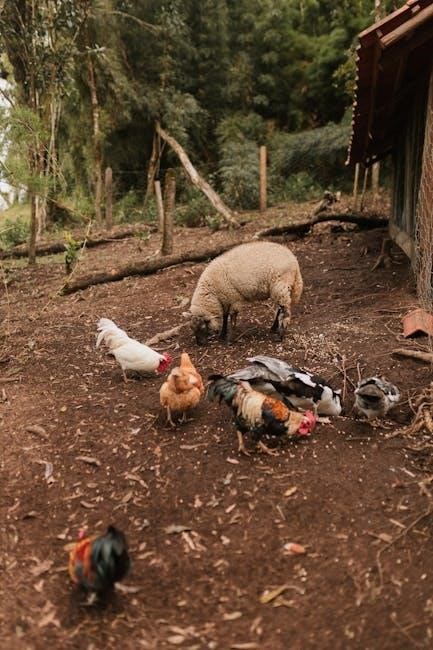Cross breeding chickens combines genetics from different breeds to enhance traits like egg production, meat quality, or disease resistance, using a customizable PDF chart for strategic planning․
What is Cross Breeding in Chickens?
Cross breeding in chickens involves the deliberate mating of two distinct breeds to produce offspring with desirable traits from both parents․ This method combines genetic material to enhance qualities such as egg production, meat quality, or disease resistance․ Farmers and breeders use tools like a cross breeding chart or PDF guide to track pairings and predict outcomes․ The process leverages genetic principles, allowing for tailored results to meet specific goals, whether for commercial production or backyard flocks․ It ensures diversity and improves overall flock performance․
Why Cross Breed Chickens?
Cross breeding chickens is a strategic approach to enhance productivity and adaptability by combining desirable traits from different breeds․ This method allows farmers and breeders to improve egg production, meat quality, and disease resistance while ensuring genetic diversity․ It also helps meet specific market demands for traits like egg color or bird size․ By leveraging a cross breeding chart or PDF guide, breeders can make informed decisions to optimize flock performance and achieve their breeding goals effectively․ This practice is beneficial for both commercial operations and backyard enthusiasts․
Benefits of Cross Breeding for Farmers and Breeders
Cross breeding chickens offers numerous benefits, including improved egg production, enhanced meat quality, and increased disease resistance․ It allows farmers to create birds with traits tailored to their specific needs, such as better adaptability to local climates or higher market demand․ This method also promotes genetic diversity, reducing reliance on a single breed․ By using a cross breeding chart, breeders can track and plan matings effectively, ensuring optimal results․ Hybrid vigor often results in healthier, faster-growing birds, making cross breeding a sustainable and profitable strategy for both small-scale and commercial operations․
The Cross Breeding Chickens Chart
A cross breeding chart is a practical tool for tracking chicken breed pairings and predicting offspring traits, helping farmers and breeders achieve desired genetic outcomes efficiently․
What is a Cross Breeding Chart?
A cross breeding chart is a detailed guide that outlines the genetic outcomes of mating different chicken breeds․ It helps farmers and breeders predict traits like egg production, growth rate, and disease resistance in offspring․ The chart typically includes information on parent breeds, desired traits, and expected results, making it an essential tool for strategic breeding programs․ By tracking mating pairs and their outcomes, breeders can improve flock productivity and maintain genetic diversity․ This resource is invaluable for both novice and experienced poultry keepers aiming to enhance specific characteristics in their chickens․
How to Create a Customized Cross Breeding Chart
Creating a customized cross breeding chart involves outlining desired traits, such as egg production or meat quality, and mapping the genetic potential of specific breed pairings․ Start by listing parent breeds and their characteristics, then track mating pairs, dates, and expected outcomes․ Include columns for trait inheritance, flock health, and offspring performance․ Use a PDF template for easy editing and sharing․ Regularly update the chart with new data to refine breeding strategies and achieve long-term goals․ This tool helps breeders make informed decisions and optimize results․
Using a PDF Chart for Record-Keeping
A PDF chart is an essential tool for tracking cross breeding programs, offering a structured format to document parent breeds, mating dates, and offspring traits․ Farmers can easily input details like egg production rates, growth patterns, and health metrics․ PDFs are accessible across devices, ensuring seamless record-keeping․ They also allow for easy sharing and updates, making it simpler to monitor progress and adjust breeding strategies․ Regularly updating the chart helps maintain accurate records, which are crucial for evaluating the success of cross breeding efforts and planning future pairings effectively․ This organized approach enhances overall flock management․
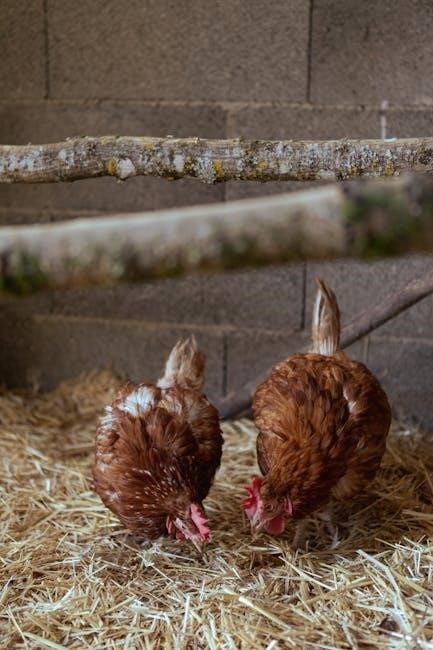
Popular Chicken Breeds for Cross Breeding
Rhode Island Reds, Leghorns, and Plymouth Rock are popular for cross breeding due to their high egg production, robust meat production, or dual-purpose traits, often featured in PDF charts․
Top Egg-Laying Breeds for Cross Breeding
Leghorns, Rhode Island Reds, and Barred Rocks are top egg-laying breeds for cross breeding, known for their high production rates and adaptability․ Leghorns produce over 280 eggs annually, while Rhode Island Reds are popular for their consistent brown egg production․ Crossing these breeds enhances egg quantity and quality․ Many PDF charts highlight these breeds for their genetic potential in improving flock productivity․ Their temperament and hardiness make them ideal for backyard and commercial setups, ensuring successful cross breeding programs focused on egg production․
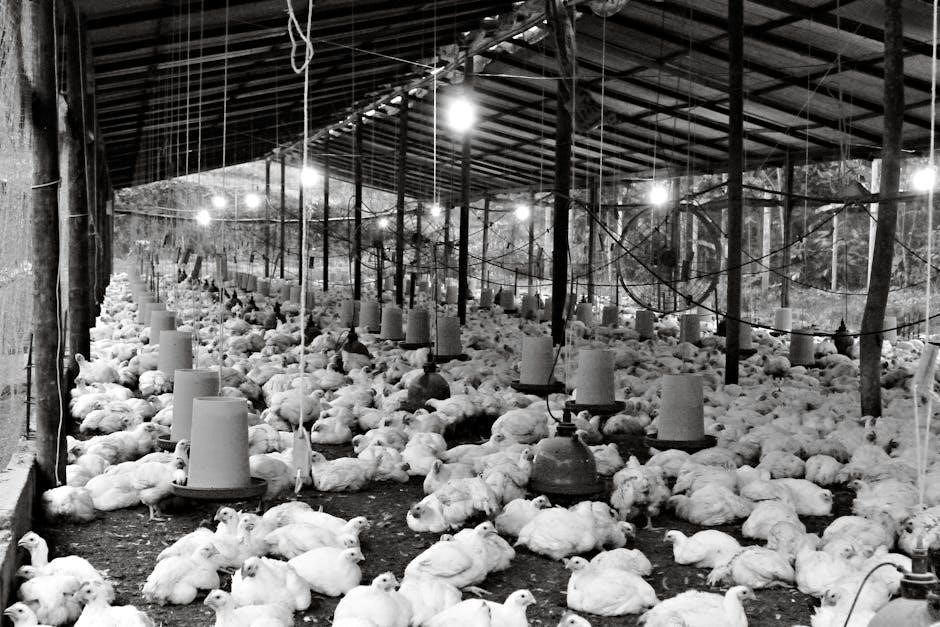
Best Meat Production Breeds for Cross Breeding
Cobb-500 and Cornish Cross are top picks for meat production, offering rapid growth and high-yield carcasses․ Heritage breeds like Plymouth Rock and Freedom Rangers are also valued for their robust health and flavorful meat․ Cross breeding these strains balances fast growth with hardiness, making them ideal for both small-scale and commercial farming․ PDF charts often highlight these breeds, providing insights into pairing strategies for optimal meat production․ Their adaptability and genetic strength ensure superior results in cross breeding programs focused on meat quality and efficiency․
Dual-Purpose Breeds for Cross Breeding
Dual-purpose breeds, such as Rhode Island Reds and Plymouth Rock, are ideal for cross breeding due to their balanced egg and meat production․ These breeds combine hardiness, good temperament, and adaptability, making them versatile for small farms and homesteads․ Cross breeding dual-purpose breeds often results in offspring with improved egg-laying ability and faster growth rates․ PDF charts help track these traits, ensuring breeders can select pairs that maintain the desired balance of productivity and resilience․ This approach is particularly useful for farmers seeking versatile, sustainable flock management․
Key Traits to Consider in Cross Breeding
Key traits in cross breeding include egg production, meat quality, temperament, and disease resistance, ensuring desired outcomes․ A PDF chart helps track these effectively․
Egg Production and Quality
Egg production and quality are critical factors in cross breeding chickens․ Breeds like Leghorns and Rhode Islanders are prized for high egg yield․ A PDF chart helps track egg production, size, and color, ensuring desired traits․ Cross breeding can enhance egg quality by combining high-yield layers with hardy, disease-resistant breeds․ Farmers use these charts to monitor genetic traits and optimize breeding strategies for consistent egg production․ Proper record-keeping ensures sustained egg quality and informs future breeding decisions effectively․ This approach maximizes productivity while maintaining egg quality standards․
Meat Quality and Growth Rate
Meat quality and growth rate are vital in cross breeding chickens for efficient poultry production․ Breeds like Cobb-500 and Cornish are often crossed for faster growth and superior meat traits․ A PDF chart helps track genetic contributions, ensuring offspring meet market standards․ Farmers monitor growth rates, muscle development, and feed efficiency․ Cross breeding enhances marbling and tender meat quality while maintaining healthy growth․ This strategic approach ensures high-yield, disease-resistant broilers, optimizing profitability for farmers and meeting consumer demand for quality meat products․ Proper record-keeping in charts is essential for achieving these breeding goals effectively․
Temperament and Hardy Behavior
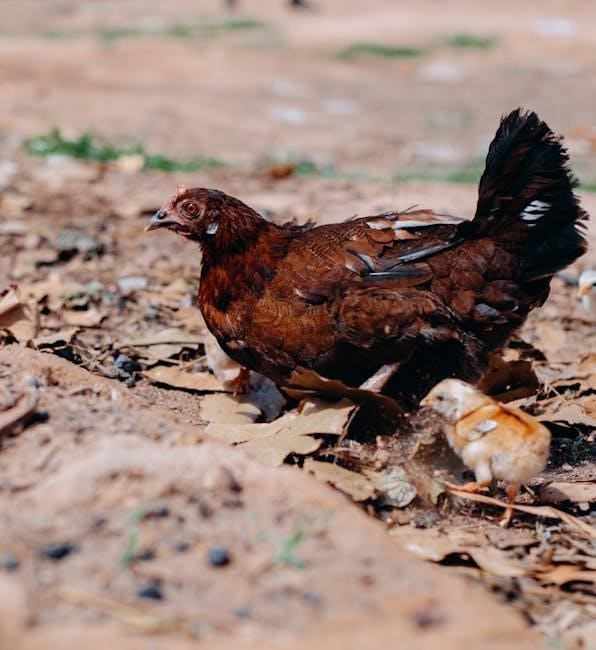
Temperament and hardy behavior are crucial for cross breeding chickens, ensuring adaptability and resilience․ Calm, docile breeds are preferred for egg production, while robust, active birds suit free-range systems․ Hardy behavior enhances disease resistance and stress tolerance, essential for outdoor flocks․ A PDF chart helps breeders track traits like foraging ability and social interaction, ensuring offspring thrive in various environments․ Cross breeding balances temperament with productivity, creating versatile, hardy birds for diverse farming conditions․ This approach supports sustainable poultry farming by prioritizing both performance and welfare․
Disease Resistance and Health
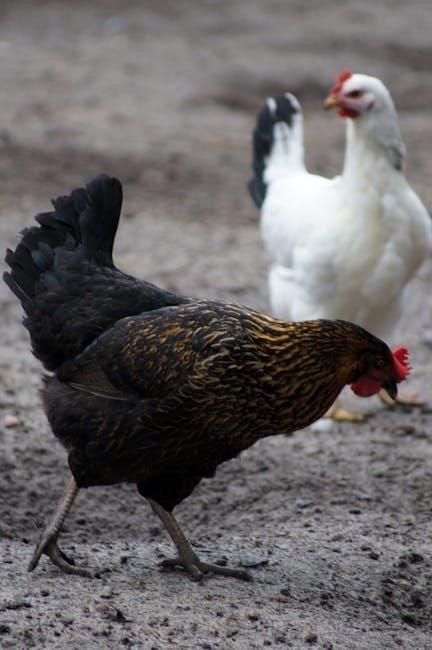
Disease resistance and health are vital in cross breeding chickens, as robust birds reduce mortality and improve productivity․ A PDF chart helps track genetic traits linked to immunity, ensuring offspring inherit resistance to common poultry diseases․ By crossing breeds with strong immune systems, farmers can minimize health issues and reliance on medications․ Healthy chickens thrive in various environments, making them ideal for both backyard flocks and commercial production․ Prioritizing disease resistance in breeding programs ensures long-term flock sustainability and profitability․ This approach supports overall poultry health management effectively․
Understanding Genetics in Cross Breeding
Genetic principles guide cross breeding, where dominant and recessive traits influence offspring characteristics․ A PDF chart maps these interactions, aiding breeders in predicting desired outcomes effectively․
Genetic Principles Behind Cross Breeding
Genetic principles form the foundation of cross breeding, where dominant and recessive traits determine offspring characteristics․ Breeders analyze these interactions to predict desired outcomes, such as improved egg production or disease resistance․ A cross breeding chickens chart PDF helps visualize these genetic patterns, enabling systematic selection of parent breeds․ By understanding how traits are inherited, farmers can strategically breed for specific qualities, ensuring offspring meet productivity and health goals․ This genetic insight is crucial for achieving successful and sustainable breeding programs․
Dominant and Recessive Traits in Chickens
Dominant and recessive traits play a crucial role in shaping chicken characteristics, influencing features like feather color, eggshell color, and comb type․ Dominant traits are always expressed when present, while recessive traits appear only in the absence of a dominant allele․ Understanding these genetic interactions is vital for cross breeding, as breeders aim to combine desirable traits from different breeds․ A cross breeding chickens chart PDF helps track these genetic patterns, enabling breeders to predict and achieve specific outcomes in their offspring effectively․ This knowledge ensures targeted breeding for improved productivity and diversity․
Sex Linking and Feather Sexing in Chicks
Sex linking and feather sexing are essential techniques in chicken breeding, allowing breeders to determine a chick’s gender early․ Sex-linked traits, like feather color, are inherited in specific patterns, making identification easier․ Feather sexing involves observing feather development, as males and females grow feathers at different rates․ These methods are particularly useful in cross breeding programs, ensuring accurate mate selection․ A cross breeding chickens chart PDF can help document these traits, aiding in strategic breeding decisions and improving flock management efficiency․ This genetic insight is key to achieving desired breed characteristics․
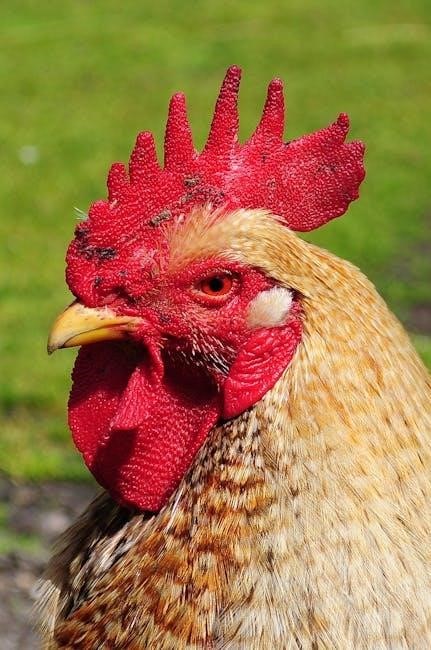
Creating a Successful Breeding Program
A successful breeding program requires clear goals, careful selection of parent breeds, and effective flock health management․ Use a cross breeding chickens chart PDF to track progress and ensure desired traits are passed to offspring, enhancing overall productivity and sustainability․
Setting Goals for Your Breeding Program
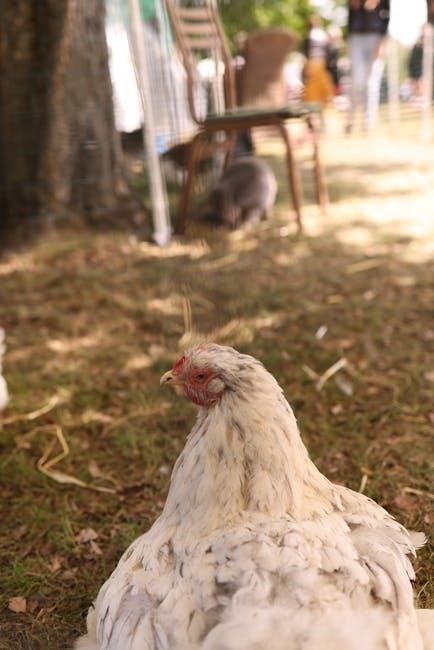
Setting clear goals is essential for a successful breeding program․ Determine whether you aim to improve egg production, enhance meat quality, or achieve specific traits like disease resistance or temperament․ Use a cross breeding chickens chart PDF to outline your objectives and track progress․ Align your goals with your farm’s needs and market demands to ensure practical outcomes․ This structured approach helps in selecting the right parent breeds and monitoring the inheritance of desired traits in offspring, ensuring your program remains focused and effective․
Selecting Parent Breeds for Desired Traits
Selecting parent breeds is a critical step in cross breeding, requiring careful evaluation of their genetic traits․ Use a cross breeding chickens chart PDF to identify breeds that excel in desired qualities such as egg production, meat quality, or disease resistance․ Assess the genetic diversity and compatibility of potential pairs to ensure hybrid vigor․ This strategic selection process ensures that the offspring inherit the best traits from both parent breeds, aligning with your breeding program’s objectives․ Tracking these selections in a chart helps predict and achieve optimal outcomes․
Managing Flock Health During Breeding
Maintaining flock health is essential during cross breeding to ensure successful outcomes․ Regular health checks, vaccinations, and parasite control are crucial․ A cross breeding chickens chart PDF can help track health metrics, enabling breeders to identify and isolate sick birds promptly․ Proper nutrition and stress management also play key roles in preventing health issues․ By prioritizing flock welfare, breeders can maximize the genetic potential of their crosses and maintain a thriving, disease-resistant population․ This proactive approach ensures the longevity and productivity of the breeding program․
Practical Applications of Cross Breeding Charts
A cross breeding chickens chart PDF is a versatile tool for tracking mating pairs, predicting offspring traits, and optimizing breeding strategies to enhance productivity and desired outcomes․
Tracking Mating Pairs and Breeding Outcomes
A cross breeding chickens chart PDF simplifies tracking mating pairs by documenting parent breeds, mating dates, and expected traits․ This tool helps monitor fertility rates, hatch success, and offspring characteristics․ By recording breeding outcomes, farmers can analyze genetic inheritance patterns and identify trends․ The chart also allows for comparisons between different breeding strategies, enabling data-driven decisions to refine future pairings․ This systematic approach ensures transparency and efficiency in achieving desired traits, whether for egg production, meat quality, or unique features․ It’s an essential resource for optimizing breeding programs․
Monitoring Trait Inheritance in Offspring
A cross breeding chickens chart PDF is vital for tracking how desired traits are passed to offspring․ By documenting inherited characteristics such as egg color, size, and production rate, farmers can assess genetic dominance․ The chart helps identify patterns in trait expression, ensuring breeding goals are met․ This data also reveals potential weaknesses, guiding adjustments in breeding strategies․ Monitoring trait inheritance enables breeders to refine their programs, enhancing the quality and consistency of their flock․ It’s a cornerstone of successful, data-driven chicken breeding․
Adjusting Breeding Strategies Based on Results
Using a cross breeding chickens chart PDF, breeders can analyze outcomes and tweak strategies for better results․ If certain traits aren’t appearing as expected, they might switch parent breeds or focus on different genetic combinations․ The chart helps identify which pairings yield the best results, allowing for informed decisions․ Over time, this iterative process refines the breeding program, ensuring it aligns with production goals․ Adjustments are key to achieving desired traits and maintaining flock performance․ This adaptive approach maximizes efficiency and success in chicken breeding․
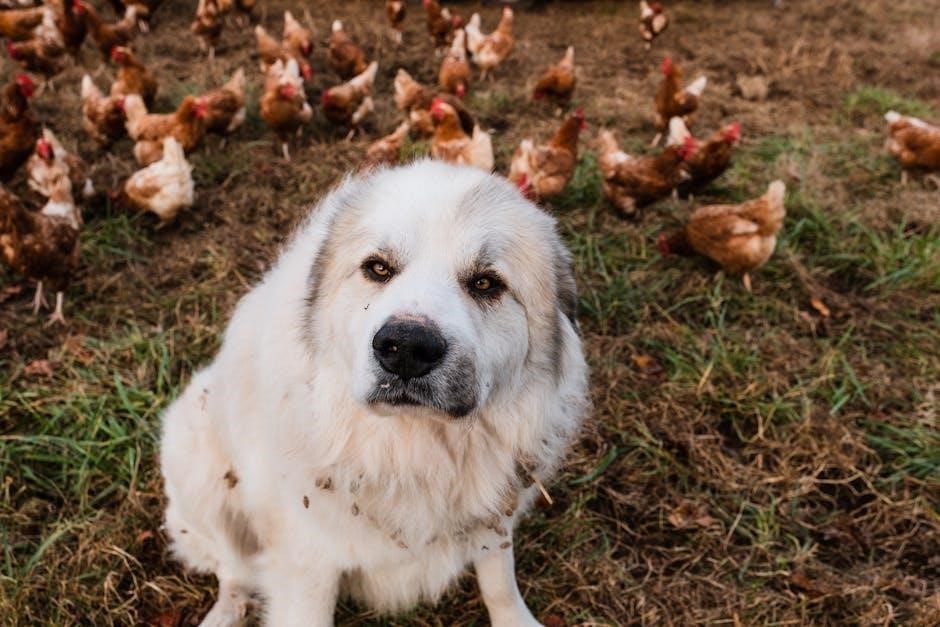
Evaluation and Selection of Breeding Stock
Evaluating breeding stock involves assessing traits, using cross breeding charts to track genetics, and selecting parents that align with desired outcomes, ensuring genetic diversity and robust health․
Assessing Exterior Qualities in Breeds
Assessing exterior qualities in chicken breeds is crucial for cross-breeding success․ This involves evaluating traits like plumage condition, feather quality, and overall physical structure․ Breeders examine size, shape, and color to ensure alignment with breeding standards․ For egg-laying breeds, egg size and shell quality are prioritized, while meat breeds focus on muscle development and body proportions․ Using a cross breeding chickens chart PDF, breeders can track and compare these traits, ensuring the selection of optimal parent stock for desired outcomes․ This step is vital for maintaining breed integrity and achieving specific production goals․
Performance Metrics for Breeding Stock
Performance metrics for breeding stock are essential in cross-breeding programs․ These metrics include egg production rates, hatchability percentages, and growth rates in meat breeds․ Farmers and breeders use these data to evaluate the productivity and efficiency of their breeding stock․ A cross breeding chickens chart PDF helps track these metrics, enabling informed decisions on which birds to select for breeding․ By analyzing performance data, breeders can enhance desired traits and improve overall flock productivity, ensuring sustainable and profitable outcomes in both egg and meat production scenarios․
Avoiding Inbreeding and Maintaining Diversity
Avoiding inbreeding is crucial for maintaining healthy and diverse chicken populations․ Inbred flocks often suffer from reduced fertility and increased disease susceptibility․ A cross breeding chickens chart PDF helps track lineage and prevent unintended inbreeding by documenting parent breeds and their offspring․ By introducing genetic diversity, farmers can enhance resilience and overall flock health․ Regularly incorporating new bloodlines ensures robust traits, making the flock more adaptable to environmental changes and market demands, thus sustaining long-term productivity and profitability in both egg and meat production systems․

Challenges in Cross Breeding Chickens
Cross breeding chickens presents challenges like managing hybrid vigor, addressing market demand for specific traits, and ethical concerns, requiring careful planning and genetic expertise to overcome․
Managing Hybrid Vigor and Health Issues
Hybrid vigor in cross-bred chickens often enhances growth and productivity, but it can also introduce health challenges․ Farmers must monitor for genetic disorders and diseases that may arise from combining breeds․ A cross breeding chart helps track health traits and identify potential issues early․ By understanding genetic principles, breeders can mitigate risks and ensure robust offspring․ Regular health screenings and proper flock management are crucial to maintaining hybrid vigor while preventing health complications in cross-bred chickens․
Addressing Market Demand for Specific Traits
Cross breeding helps meet market demands by targeting specific traits like egg color, size, or meat quality․ Breeders use detailed charts to track desired characteristics, ensuring offspring meet consumer preferences․ For example, breeding for blue eggs or faster growth aligns with market trends․ This approach requires balancing genetic diversity with trait specificity to avoid compromising overall health․ By tailoring breeding programs, farmers can satisfy niche markets and stay competitive, making cross breeding a versatile tool for adapting to evolving consumer demands in the poultry industry․
Ethical Considerations in Breeding Practices
Cross breeding chickens raises ethical concerns, particularly regarding animal welfare and genetic diversity․ Breeders must avoid practices that prioritize productivity over health, such as extreme trait selection leading to deformities or stress․ Maintaining genetic diversity is crucial to prevent inbreeding issues and ensure long-term flock health․ Ethical breeding practices emphasize natural behaviors, proper living conditions, and avoiding unnecessary suffering․ Balancing economic goals with humane treatment ensures sustainable and responsible cross breeding, aligning with ethical standards in poultry production․
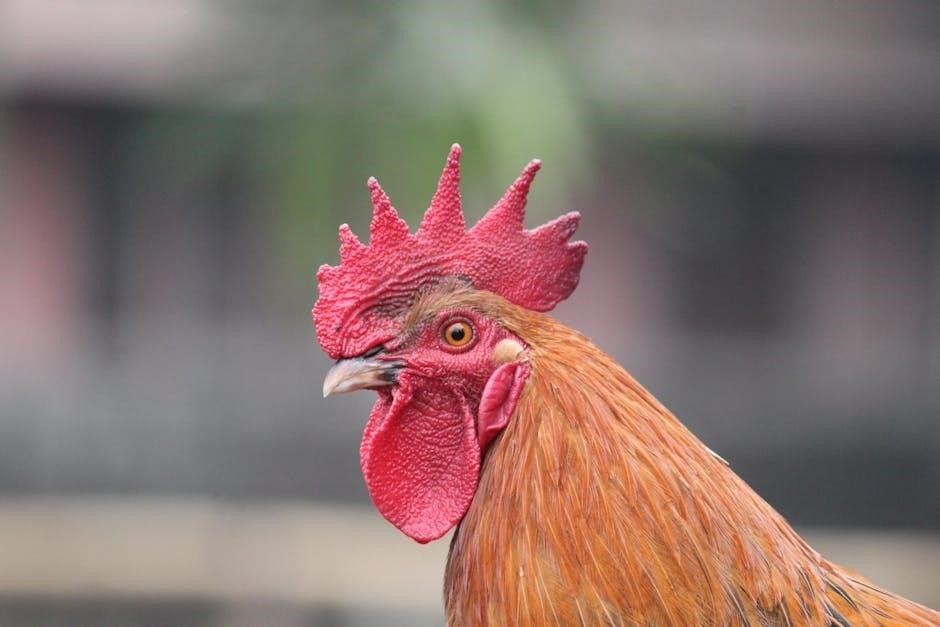
Resources and Tools for Breeders
Download free PDF cross breeding charts and guides to track traits, egg production, and growth rates․ Join online communities for expert advice and shared knowledge․
Recommended Breeds for Backyard Flocks
For backyard flocks, popular breeds like Rhode Island Reds, Leghorns, and Plymouth Rock are ideal for egg production․ Orpingtons and Easter Eggers are great for their friendly temperament and unique egg colors․ Dual-purpose breeds such as Australorps and Wyandottes balance egg-laying and meat production․ Heritage breeds like Ameraucanas and Barred Rocks are also excellent choices for their hardiness and adaptability․ A cross breeding chart can help select breeds that align with your goals, whether for eggs, meat, or companionship․ These breeds are widely recommended for their performance and ease of care in small-scale settings․
Free PDF Charts and Guides for Download
Downloadable PDF charts and guides provide comprehensive tools for cross breeding chickens․ These resources offer detailed breed comparisons, genetic trait tracking, and mating strategies․ Many charts include space for recording flock performance, egg production, and health metrics․ Customizable templates allow breeders to tailor the information to their specific needs․ Free guides often cover topics like dual-purpose breeds, heritage lines, and hybrid vigor․ Print-friendly formats make it easy to maintain physical records․ These resources are invaluable for both experienced breeders and newcomers, offering a structured approach to achieving breeding goals effectively․
Online Communities and Expert Advice
Online communities and forums dedicated to poultry breeding offer invaluable support for cross breeding chickens․ Platforms like Facebook groups, Reddit forums, and specialized breeding websites connect enthusiasts and experts worldwide․ These spaces allow breeders to share experiences, discuss challenges, and gain insights into successful strategies․ Many experts provide free or paid consultations, offering tailored advice on creating cross breeding charts and improving flock performance․ These resources are particularly useful for newcomers, helping them navigate genetic principles and breeding best practices effectively․
Cross breeding chickens is pivotal for modern poultry, enhancing productivity and sustainability․ Future trends integrate advanced genetics and AI-driven charts for superior breeding strategies and disease resistance․
The Role of Cross Breeding in Modern Poultry
Cross breeding plays a crucial role in modern poultry by combining desirable traits from different breeds to enhance productivity․ Farmers and breeders use charts to track genetic outcomes, ensuring improved egg production, meat quality, and disease resistance․ This method allows for tailored breeding programs, meeting market demands efficiently․ By leveraging genetic diversity, cross breeding supports sustainable poultry farming, ensuring healthier flocks and higher yields․ It remains a cornerstone of advancing poultry production in both commercial and backyard settings․
Emerging Trends in Chicken Breeding
Emerging trends in chicken breeding focus on genetic advancements and sustainable practices․ Breeders are increasingly using cross breeding charts to optimize traits like egg production and disease resistance․ Digital tools, including PDF guides, facilitate precise tracking of breeding outcomes․ There is a growing emphasis on heritage breeds and hybrid vigor to meet market demands․ Additionally, ethical breeding practices and environmental considerations are gaining prominence, ensuring a balance between productivity and animal welfare in modern poultry farming․ These trends underscore the evolution of chicken breeding as a science-driven industry․
